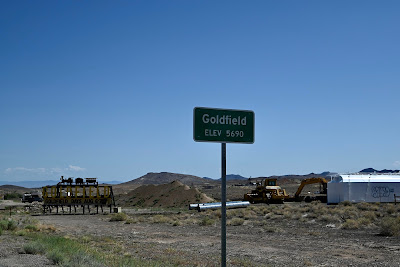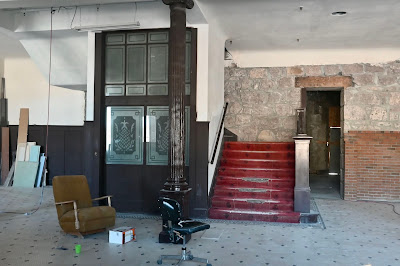Goldfield, was one of the great boomtowns of the early 1900s. Gold was discovered in 1902. Within four years, it had 30,000 residents. From 1906 to 1910 Goldfield was the largest city in Nevada. Total production in 1901 was over $3 million dollars, at about $12.40 a troy ounce silver. From 1901 thru 1940 Goldfield recorded production over $90,000,000, mainly in gold. In today's prices, that's about $1.8 billion dollars.
But the town was hit by fires (1905 and in 1906) destroyed several businesses and a flash flood (1913). In 1923 a fire leveled 54 square blocks. The gold dried up. And by 1923, the population was under 1000. Today, Goldfield is a near ghost town with under 270 residents - but many architectural reminders of the good old days.
 |
| The Goldfield Hotel |
 |
| Nan in front of the building |
The Goldfield Hotel: Opened in 1908 is four stories of stone and brick. The structure cost over $300,000. The original plans called for 150 rooms and 45 suites with private baths. Each room had a telephone, and the building was heated by steam. The lobby had luxurious mahogany paneling and leather banquettes. The hotel is one of the largest and most notable "ghost buildings" in the West.
 |
| "Tex" Rickard House |
Another Goldfield landmark is the "Tex" Rickard House. To promote Goldfield, he and others staged a prize fight on Labor Day, 1906. Joe Gans and Battling Nelson fought for the Lightweight Championship of the world. In the 42nd round Nelson was disqualified, and Joe Gans was declared the winner of the $30,000 purse.
 |
| Saloon |
 |
| Santa Fe Motel |
The Santa Fe Saloon (1905) is one of Goldfield's oldest continuously-operating businesses. Today, the Santa Fe, with its eight motel rooms, is still a popular oasis.
The Mozart Tavern (formerly the Hoist House) is located at the corner of Crook/Hwy 95 and North Columbia. The building boasts an authentic atmosphere and is a favorite for locals as well as tourists.
 |
| Courthouse |
Esmeralda County Courthouse built in 1907, when the county seat transferred to Goldfield from Hawthorne, NV, it is still the County seat today.
Goldfield Fire Station #1 built in 1907, served as the town's fire house until June 2002.
Goldfield High School built in 1907. The 3-story structure was designed by J.B. Randall. It has a floor area of over 19,656 square feet. The interior has 12 classrooms, an auditorium, 2 offices, 2 bathrooms, 4 storage rooms, and extra-large attic and a seating capacity of 450. The first year's enrollment was 125 students and about 25 faculty members. When we visited, it was close due to their efforts in restoring the Goldfield High School.
Some of the more famous visitors and residents of Goldfield included Virgil and Wyatt Earp, George Wingfield, Death Valley Scotty, Jack Dempsy, and Governor and late U. S. Senator Tasker Oddie.
 |
| Virgil Earp |
 |
| Allie Packingham Sullivan Earp |
Virgil Earp and his wife Allie (Alvira) arrived in Goldfield. Shortly after his arrival, Virgil was sworn in as a deputy sheriff of Esmeralda County, and served right up to his death on October 19, 1905. He died of pneumonia in the Saint Mary's County Hospital on Euclid Ave, Goldfield, while holding his wife's hand as he laid in bed. They were together for thirty-two years.
Our visit gave us a sense of what it was like to live in gold rush boomtown in early 20th century. Great fun exploring and investigating around the town. Of course, great photography as well.
Here are few more photos:
Thanks for reading, safe travels!














